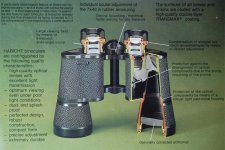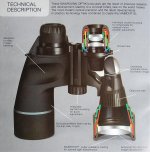Habicht's aren't the best birding binoculars out there. Far from it. The focuser is too tight, they can have glare issues and the eye cups are too small, at least on the W. The GA or armored version do have bigger eye cups, and you can help the glare and small eye cups on the W with a Bino Bandit. But dang are they BRIGHT! For the aperture size, they are one of the brightest binoculars I have ever looked through. The 8x30, 10x40 and 7x42 all have 95 % transmission, which is more than any binocular I know of. Not even the legendary Nikon E2 8x30 can compete with their transmission numbers, so being a porro might help with that super high transmission, but there must be other reasons they are so bright. I have heard they have the best EL glass and the best updated coatings Swarovski can put on a binocular, so that must be part of it combined with the fact that porros have a simpler optical system and the prism is 100% efficient unlike the best roof prisms which have to be phase and dielectric coated and still can't touch the transmission figures of the Habicht. Probably, the only roof prism that comes close to a Habicht in transmission is the Zeiss HT, and it is only 93% at 500 nm. At wavelength 500 nm Nikon SE 8x32's have 85% transmission, Swarovski NL 8x42's have 92% transmission, Zeiss Conquest HD 8x32's have 89% transmission, Swarovski CL's 8x30 have 90% transmission, Meopta Meostar's 8x32 have 85% transmission and the famous Nikon E2 8x30(New Version) only have 87% transmission. Of the three Habicht's I have found the 7x42 to be generally the brightest because of it's bigger exit pupil, but even the smaller 8x30 is amazingly bright for it's small aperture. The Habicht 7x42 is for the aperture size one of the brightest binocular I have ever looked through. They almost seem like they are self illuminated from within! The weird thing about transmission is it helps more in the daylight than exit pupil, and exit pupil helps more in low light. Higher transmission increases the brightness of the cone of light reaching your eyes, so a higher transmitting binocular can appear brighter even in the day, and it will even create a sparkle to the image which can be addictive. Habicht's sparkle in the daylight like no other binocular I have used and of course they have that 3D porro image which is hard to underestimate what a difference it makes in your view. Again, I am not recommending Habicht's for an all around birding binocular, but for the price and aperture I don't think any binocular will outperform them in the quality of the view. Dang, those Habicht's are bright!
Attachments
Last edited:











